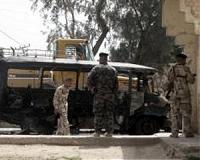| . |  |
. |
Los Angeles CA (SPX) Jan 20, 2011 Military tension between North Korea and the Republic of Korea (South Korea) extends to areas of the Yellow Sea. Now defence experts based in the Republic of Korea have devised improved methods to model underwater warfare, which they believe can aid future decisions about weapons and defence purchases. The details appear in the Journal of Defense Modeling and Simulation, published by SAGE. The researchers based at the Korea Advanced Institute of Science and Technology (KAIST) and Seowon University, both in the Republic of Korea, set out to design an underwater warfare model to gain insight into how factors such as tactics and the performance of underwater weapons influence the measurement of effectiveness (MOE) of a weapons system. Governments considering whether to purchase equipment, such as torpedoes or mobile decoys, use these types of modelling and simulation as part of their decision making process both for purchases, and for making tactical decisions. The new model uses DEVS formalism. DEVS - Discrete Event System Specification - is a widely used, modular and hierarchical technique for modelling and analyzing general systems. In their paper, the authors introduce a co-modelling methodology for flexible model architecture, which they use to model the underwater warfare system: "In the underwater warfare model, change in detailed algorithms and dynamic equations, such as sensor algorithms, is more frequent than the change in the abstract behavior," explains corresponding author, Kyung-Min Seo. "Therefore, by separating abstract behavior and detailed algorithms, we can test candidate tactics or algorithms of underwater platforms with minimal modification of the model." One drawback of previous modelling approaches has been that a model cannot be re-used. The Korean researchers overcame this by using a three-part modelling methodology that provides generic representations of underwater platforms. This meant that each sub-model - in this case, a controller model, a sensor model, and a manoeuver model - was then reusable for other platform models. The researchers tested their model with extensive combat simulations, to investigate the impact of parameters such as tactics or weapons performance on an anti-torpedo combat system's effectiveness. For instance, in the case of simulation of a surface ship's evasion of a torpedo, they use factors including the detection range of a surface ship, the pattern of the decoy operating system, and the speed and operating time of the decoy. "Experimental results support assessment of anti-torpedo countermeasure effectiveness and the decision-making process for future equipment procurements," Seo suggests. However, he adds that external environmental factors, such as wind speed and ocean current, were not included in this model, which was based on a passive sonar system. The next challenge, to include multi-static acoustics within the underwater environment using multiple sonars, along with environmental factors, is the team's goal for future research.
Share This Article With Planet Earth
Related Links Korea Advanced Institute of Science and Technology (KAIST) The latest in Military Technology for the 21st century at SpaceWar.com
 LockMart Receives Urban Operations Training System Contract Award
LockMart Receives Urban Operations Training System Contract AwardOrlando FL (SPX) Jan 20, 2011 The U.S. Army's Program Executive Office of Simulation, Training and Instrumentation awarded Lockheed Martin an indefinite delivery/indefinite quantity contract to provide Urban Operations Training Systems (UOTS) for the U.S. Army, Army Reserve and National Guard. The award includes an initial $22,000 delivery order with a potential value of $287 million over five years. "We believe this t ... read more |
|
| The content herein, unless otherwise known to be public domain, are Copyright 1995-2010 - SpaceDaily. AFP and UPI Wire Stories are copyright Agence France-Presse and United Press International. ESA Portal Reports are copyright European Space Agency. All NASA sourced material is public domain. Additional copyrights may apply in whole or part to other bona fide parties. Advertising does not imply endorsement,agreement or approval of any opinions, statements or information provided by SpaceDaily on any Web page published or hosted by SpaceDaily. Privacy Statement |